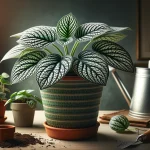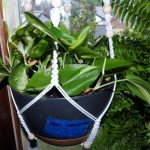This post may contain affiliate links. If you buy something from one of our links we may earn a commission. Thanks
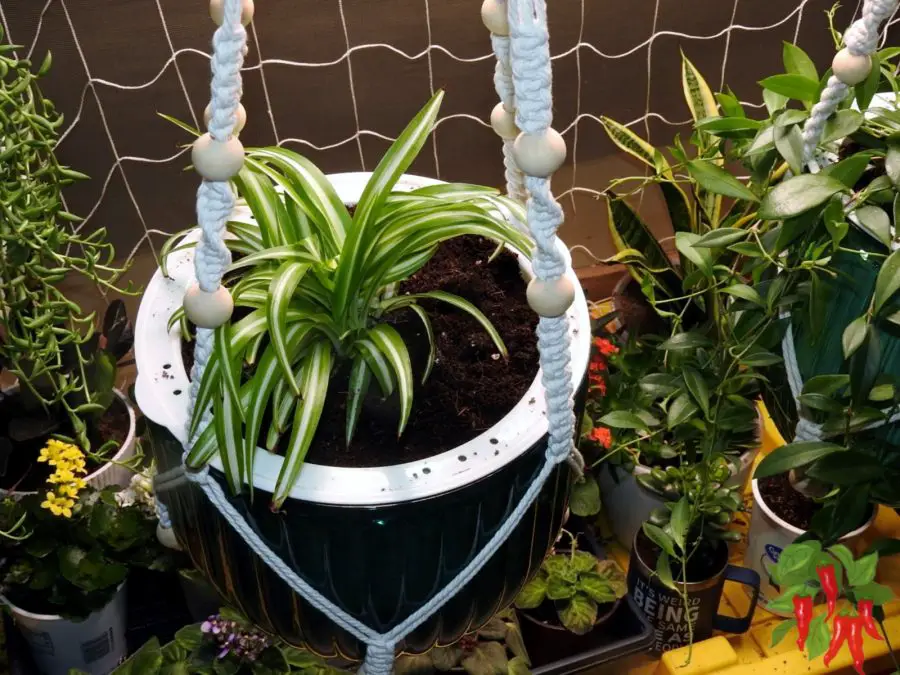
Variegated Spider Plant Care is super easy once you know what this laid-back beauty really loves.
If you want those bold stripes to stay bright and the leaves lush and full, a few simple habits make all the difference.
Stick with me and I’ll walk you through exactly how to keep your spider plant happy, healthy, and thriving.
Variegated Spider Plant Care Key Takeaways
- Variegated Spider Plant Care involves bright, indirect light, lightly moist but well-draining soil, and monthly feeding during spring and summer.
- Use distilled water to avoid brown tips and prune as needed.
- Propagate easily from plantlets or by division.
- This pet-safe, low-maintenance plant thrives in most indoor spaces with very little fuss.
Variegated Spider Plant Care Video
Variegated Spider Plant Care: A Friendly Guide for Beginners
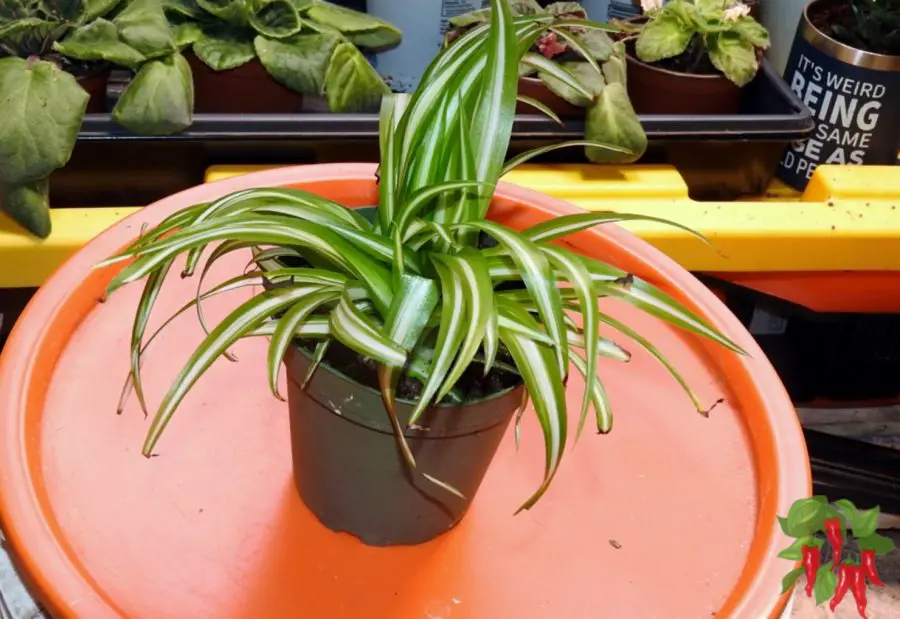
Variegated spider plants (Chlorophytum comosum ‘Variegatum’) are popular houseplants known for their striking green and white striped foliage and air-purifying qualities.
They are cherished for their resilience and ease of care, making them ideal for both novice and seasoned plant enthusiasts. Chlorophytum comosum – Wikipedia
Why I Finally Got a Variegated Spider Plant
You know, I avoided spider plants for years. Maybe it was because they reminded me too much of grandma’s living room, hanging in that same old macrame planter.
But the truth is, this plant’s a classic for a reason. I finally picked up a variegated spider plant from California Tropicals, and now I’m wondering why it took me so long.
If you’re new to indoor gardening, this one’s about as beginner-friendly as it gets. It’s easy to care for, not picky about humidity, and it won’t freak out if you forget a watering here or there.
Plus, it’s non-toxic, which makes it a great pick for pet lovers and parents alike. Whether you tuck it into a shelf or let it spill over in a hanging basket, this plant adds instant charm without the drama.
In this guide, I’ll walk you through everything you need to know about variegated spider plant care—drawing straight from my own growing setup, tips, and a few honest thoughts from my journey so far.
I. Introduction to Spider Plant Care

A. Overview of Variegated Spider Plants
The variegated spider plant (Chlorophytum comosum ‘Variegatum’) is one of those houseplants that just feels like home.
It’s known for its long, arching leaves striped with creamy white edges and a deep green center that look like they’re pouring out of the pot.
Whether it’s hanging from a macrame planter or perched on a shelf, this plant brings a graceful, almost waterfall-like vibe to any room.
When I got mine, I couldn’t stop looking at it. The stripes are bold, but not flashy. It’s got this calm, classic beauty that works in just about any style of decor.
And while there are a few types out there—some with curly leaves, some with reverse variegation—the standard variegated version I picked up is a real show-stealer.
B. Popularity as Houseplants
Spider plants have been a houseplant favorite for decades. I used to skip over them, thinking they were too common.
But here’s the thing: sometimes something’s popular for a reason.
These plants are:
- Low-maintenance: They don’t ask for much and bounce back from a little neglect.
- Air-purifying: NASA even gave them a nod for their ability to clean the air.
- Pet-friendly: You don’t have to worry if your cat gets curious.
- Versatile: They work in hanging baskets, on shelves, or even grouped in a plant cluster.
Honestly, now that I’ve got one in my collection, I can see why it’s stuck around all these years. It’s easy to grow, great for beginners, and still a real beauty.
II. Variegated Spider Plant Varieties
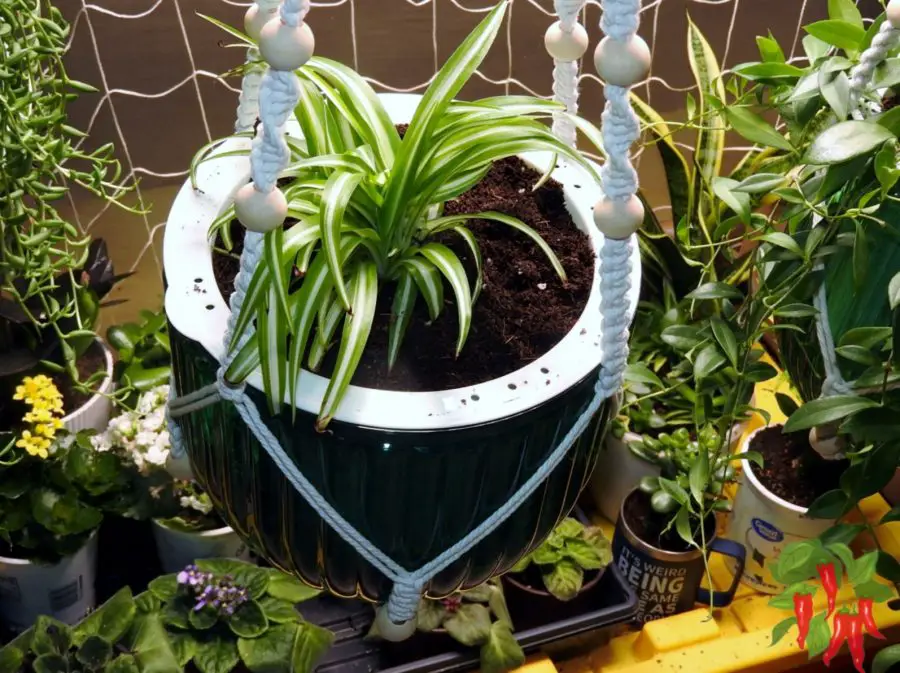
When I first went looking for a spider plant, I was surprised at how many different kinds were out there.
They all fall under the spider plant family, but each variety has its own twist—literally, in some cases.
Here’s a rundown of the most popular types of variegated spider plants so you know what you’re looking at (or shopping for).
A. ‘Vittatum’
This is probably the one most people picture when they think of a spider plant. It’s got long, arching green leaves with a bold white stripe running down the center.
It’s a true classic and yep, it’s the variety you probably saw hanging in grandma’s kitchen window. This one’s super common, easy to grow, and looks fantastic in a hanging basket.
B. ‘Variegatum’
This variety flips the script. Instead of a white stripe down the middle, the white hugs the edges of the leaf, leaving a solid green center.
It’s slightly more formal-looking than ‘Vittatum’ and just as low-maintenance. I went with this type for my own plant, and I love the clean, crisp look of those margins.
C. ‘Bonnie’
If you like your plants with a bit of flair, ‘Bonnie’ might be your favorite. It has the same green and white striping as ‘Vittatum,’ but the leaves twist and curl like a ribbon.
It’s got that wild, whimsical vibe and looks great in smaller hanging pots or as a little tabletop accent.
D. ‘Hawaiian’
This one’s a bit of a show-off in the best way. The ‘Hawaiian’ spider plant features broader, glossy leaves with a subtle yellow-green variegation.
It’s a little more tropical-looking and stays more compact, making it perfect for folks short on space.
E. ‘Reverse Variegated’
As the name suggests, this type has the opposite pattern of ‘Vittatum.’ The center of the leaf is dark green, while the edges are creamy white.
It’s not as widely available, but it’s a stunner if you can find one. Definitely worth adding to your collection if you want something a little different.
Each variety brings a unique look, but they all share the same easygoing care needs. So whether you’re drawn to the curls of ‘Bonnie’ or the classic stripes of ‘Vittatum,’ you really can’t go wrong.
III. Ideal Growing Conditions
Even though spider plants are laid-back, giving them the right environment helps them really shine.
The variegated types especially benefit from the proper light, temperature, and soil. Here’s what’s worked for me and why this plant is such a low-fuss winner.
A. Light Requirements
Spider plants love bright, indirect light. I keep mine near a window that gets plenty of soft morning light—an east-facing window works great. Direct sun, especially in the afternoon, can scorch those beautiful white stripes and turn the tips brown.
From the video:
“It likes bright indirect light. So no direct sunlight. I mean, you could put it in an east window and it’ll get a little bit of morning sun and that’s fine, but you don’t want it out in full afternoon sun.”
If your space is a little darker, the plant will still grow, but you might notice the variegation fading. The stripes won’t be quite as bold, but the plant will stay healthy.
B. Temperature and Humidity
One of the things I love about this plant? It doesn’t fuss about humidity. A lot of tropical plants get dramatic if the air’s too dry, but not the spider plant.
“It’s a tropical plant. But most of them require higher humidity. The spider plant—it doesn’t care. It’s fine with whatever humidity you have in your house.”
Keep it in a room that stays between 65°F and 75°F (18°C – 24°C), and it’ll be perfectly content. No need for a humidifier or misting unless your air is bone dry.
C. Soil Preferences
Spider plants do best in a well-draining, loamy mix. They like moisture, but they hate soggy roots. That’s why I transplant almost all my houseplants into coco coir.
“I have this one in Coco Core, and I pretty much transplant all my plants into Coco Core.”
Coco coir holds just the right amount of moisture without getting heavy. Pair it with some perlite or pumice for extra drainage, and you’ve got a light, breathable mix that keeps the roots happy.
With the right balance of light, temperature, and soil, your variegated spider plant will thrive and make your space feel a little more alive.
IV. Watering and Fertilization
Spider plants are forgiving, but they’ll thank you for getting the watering just right. It’s not rocket science—just a little rhythm and a bit of observation. Here’s what works for me and keeps those variegated leaves looking fresh.
A. Watering Guidelines
Spider plants like their soil to stay lightly moist—but not soggy. Let the top inch or two of the soil dry out before watering again. When you do water, give it a solid soak so water drains freely out the bottom. Then, empty the tray and let the plant dry out a bit before the next drink.
From the video:
“If you’re just watering by hand, let the top couple of inches of soil dry out and then water it again. But water it thoroughly. Give your plant a soaking to where water runs out the bottom, then drain the tray and let it dry down again.”
I personally use self-watering planters for nearly all my houseplants, including this one. They’re game-changers especially if you tend to forget a watering or two.
“This one is a Melphoe, and it’s an 8.3-inch hanging basket with a macrame hanger… the inner pot has some cotton wicks that hang down into the water and wick the water up to the plant.”
That wick system pulls just the right amount of moisture up to the roots. It also keeps water off your floors and furniture—a win all around.

Melphoe Self Watering Hanging Planters, 1 Pack 8.3 Inch Hanging Basket, 2 Kinds of Hangers Macrame 35.5″ & Metal Chain 19.6″
Oh, and one quick tip: use distilled or purified water if you can. Spider plants are sensitive to fluoride in tap water, and over time it can cause those dreaded brown tips.
B. Fertilization Practices
Spider plants don’t need a lot of feeding, but they do benefit from a little boost during their active growing season typically spring through summer.
I recommend using a balanced, water-soluble fertilizer once a month. Think something like a 10-10-10 or 20-20-20 mix, diluted to half strength.
Just be careful not to overdo it.
“Over-fertilization can lead to leaf tip burn, which nobody wants. So when in doubt, go easy.”
And honestly, if you forget a feeding or two? This plant isn’t going to hold it against you.
With the right watering rhythm and a touch of fertilizer, your variegated spider plant will reward you with healthy growth and those signature stripes.
V. Common Issues and Solutions
Even though variegated spider plants are tough little survivors, they’re not completely immune to problems. The good news?
Most issues are easy to fix once you know what to look for. Here are a few common troubles I’ve run into or dodged with some simple solutions that work.
A. Brown Leaf Tips
If you’ve got brown, crispy tips on your spider plant’s leaves, don’t panic. It’s one of the most common issues, and the plant isn’t dying—it’s just a little annoyed. The usual suspects? Low humidity, too much fertilizer, or fluoride in tap water.
From the video:
“This plant likes moist soil, but not soggy soil… And if you’re just watering by hand, let the top couple of inches of soil dry out and then water it again. But water it thoroughly…”
Fix it with:
- Distilled or purified water instead of tap
- Cutting back on fertilizer, especially in winter
- Optional humidity boost if your home air is extra dry
I also trim off the brown tips with clean scissors if they bug me. Just avoid cutting into the green part.
B. Pests
Spider plants are pretty pest-resistant, but every now and then they might attract unwanted visitors like aphids, mealybugs, or spider mites—especially if they’re stressed or nearby plants are infested.
What to watch for:
- Sticky residue
- Cotton-like fuzz
- Fine webbing
Quick fixes:
- Wipe the leaves with a damp cloth
- Spray with insecticidal soap or neem oil
- Isolate the plant if needed until things clear up
Regular check-ins help a lot. I give my plants a once-over every time I water just to stay ahead of trouble.
C. Root Rot
Root rot is the one issue that can really knock your plant down for the count. But it’s totally avoidable.
It usually happens when the roots sit in soggy soil for too long. That’s why I swear by good drainage and those self-watering planters I mentioned earlier.
“The inner pot has some cotton wicks that hang down into the water and wick the water up to the plant… So you don’t have to worry about over or under watering.”
To prevent root rot:
- Always use pots with drainage holes
- Let soil dry slightly between waterings
- Use a light, breathable mix like coco coir and perlite
If your plant’s leaves are wilting, yellowing, or feeling mushy near the base, it might be time to check the roots.
Stay on top of these little issues and your spider plant will stay happy, healthy, and ready to send out those adorable plantlets.
VI. Pruning and Maintenance
Spider plants are some of the easiest plants to maintain, but a little upkeep goes a long way in keeping them looking fresh and encouraging new growth.
Whether it’s snipping off dead leaves or waiting for those adorable little plantlets (aka spiderettes) to show up, here’s how I keep mine in good shape.
A. Pruning Guidelines
One of the first things I do when checking on my spider plant is look for any tired leaves, those yellowing, dried-out ones that just aren’t pulling their weight anymore.
Pruning those off not only makes the plant look better, but it helps redirect energy to healthy growth.
From my experience:
I just reach in and snip the brown or yellow leaves at the base with clean scissors or pruning shears. It’s quick, easy, and keeps the plant looking tidy.
Here’s the pruning playbook:
- Remove yellow or brown leaves at the base, not halfway up the leaf
- Trim brown tips if they’re unsightly, but don’t cut into the green part
- Cut off flower stalks once they fade to conserve energy
Your spider plant won’t sulk after a trim and it usually perks up.
B. Encouraging Plantlets (‘Spiderettes’)
One of the coolest things about spider plants is how they make babies. These little offshoots dangle down from long stems, ready to become full-grown plants themselves.
They usually appear when the parent plant is mature and living its best life.
From the video:
“It makes long, hanging stems down and they have what we call spiderettes, which are little offshoots or pups that you can cut off and transplant.”
To encourage those spiderettes:
- Give your plant bright, indirect light
- Keep it in a slightly root-bound pot (they love it a little snug)
- Don’t over-fertilize—a light monthly feeding is enough
- Provide steady care—nothing fancy, just consistency
Once those pups have little roots, you can snip them off and plant them. Or leave them attached and let the whole setup cascade beautifully.
A bit of snipping and some solid care is all it takes to keep your spider plant looking like a million bucks and multiplying like one too.
VII. Propagation Techniques
One of the best things about owning a variegated spider plant? You don’t just get one plant. You get a whole crew.
These little guys are super generous when it comes to propagation. Whether it’s through plantlets or root division, sharing or expanding your collection is simple and satisfying.
A. Propagating from Plantlets
Spider plants are famous for their plantlets, those mini versions of themselves that grow on long arching stems. Once they start popping out roots, they’re ready to go off on their own.
From the video:
“It makes long, hanging stems down and they have what we call spiderettes, which are little offshoots or pups that you can cut off and transplant and grow again.”
Here’s how I do it:
- Wait until the plantlet has visible roots (you’ll see little white nubs forming underneath)
- Snip it off with clean scissors
- Pot it up in moist, well-draining soil (I use coco coir with a bit of perlite)
- Keep it in bright, indirect light and lightly water it until it gets settled
You can also root the plantlet in water first if you want to watch the roots grow before planting. Either way, these pups are eager to take off.
B. Division Method
If your spider plant is getting crowded or root-bound, repotting is a great time to divide it and create a few new plants in one go.
It’s as easy as gently splitting the root ball and potting up each section separately.
Here’s the step-by-step:
- Remove the plant from its pot and shake off excess soil
- Look for natural separations in the root mass (they often split easily)
- Use a clean knife or your hands to divide the plant into two or more sections
- Pot each section into its own container with fresh soil
The divided plants will bounce back quickly, especially in spring or summer when they’re actively growing.
So whether you’re giving plantlets to friends or turning one big plant into several, spider plant propagation is one of the most rewarding parts of growing them.
VIII. Repotting Recommendations
Spider plants aren’t fussy, but when they start getting too cozy in their pot, they’ll let you know.
A little root crowding is actually good for encouraging plantlet production, but once things get out of hand, it’s time to give your plant a fresh start.
A. When to Repot
The telltale signs it’s time to repot?
- Roots circling the surface or poking out the drainage holes
- The plant drying out faster than usual
- Slower growth or general droopiness
I noticed mine was getting snug in its 4-inch pot not long after I brought it home.
From the video:
“This plant is pretty small right now. It was in a four-inch pot. It will get quite a bit bigger…”
A good rule of thumb? Check your spider plant once a year, and repot every 1–2 years depending on how fast it’s growing.
And here’s a bonus tip:
- Repotting time is also the perfect time to divide your plant if it’s large enough.
- If you’ve got multiple clumps growing in the same pot, just separate them gently and give each their own container.
- It’s an easy way to multiply your plant collection without doing much extra work.
B. Repotting Steps
When it’s time to give your spider plant some room to stretch, here’s what to do:
- Pick a new pot that’s just one size larger—don’t go too big too fast. Make sure it has drainage holes to prevent soggy roots.
- Use fresh, well-draining potting mix. I’m a big fan of coco coir mixed with perlite—it’s light, airy, and holds moisture without getting compacted.
- Gently remove the plant from its current pot and loosen the root ball with your fingers. If it’s really root-bound, don’t be afraid to break it up a little.
- Place the plant in its new home, fill in around the sides with your soil mix, and water thoroughly.
Pro tip: If you’re using a self-watering pot like the one I use, make sure the wick system is set up properly before you plant. It makes watering a breeze and helps avoid root rot. Now it’s really ready to thrive!
IX. Benefits of Variegated Spider Plants
If you’re still on the fence about adding a variegated spider plant to your home, let me tell you this plant isn’t just easy on the eyes, it actually does stuff too.
From cleaner air to pet-safe peace of mind, it earns its place in any indoor space.
A. Air Purification
This isn’t just houseplant hype—spider plants are legit air cleaners. They’ve even been featured in NASA’s Clean Air Study for their ability to remove toxins like formaldehyde, xylene, and carbon monoxide from indoor air.
Think of it as a leafy little air filter quietly doing its job while looking fabulous.
B. Pet-Friendly
One of the first things I check before buying any plant is whether it’s safe for pets. Good news here—variegated spider plants are non-toxic to cats and dogs. That’s a big deal if you’ve got curious animals that like to nibble on greenery.
From the video:
“It’s also non-toxic, which is great if you have pets or kids.”
Now, your cat might still bat at the spiderettes like they’re toys but at least you don’t have to panic about a vet visit.
C. Aesthetic Appeal
Variegated spider plants just have that effortless beauty. The long, striped leaves arching out from the center create a fountain-like shape that brings a soft, flowing feel to any space.
They work well:
- In hanging baskets (especially with a macrame hanger)
- Cascading off shelves or plant stands
- Grouped with other houseplants for that jungle vibe
From the video:
“It’s great for hanging baskets or just letting it trail down a shelf.”
Whether you’re going for cozy, modern, boho, or something in between, this plant fits right in.
So yeah, the variegated spider plant is more than just a pretty face. It helps clean your air, plays nice with pets, and makes any room feel more alive.
X. Variegated Spider Plant Care Conclusion
Caring for a variegated spider plant isn’t complicated but it sure is rewarding. With its striped leaves, air-purifying perks, and easygoing nature, this plant earns its spot in any indoor jungle.
Whether you’re a first-time plant parent or a seasoned grower, a few simple care habits can keep your spider plant thriving for years.
A. Recap of Care Tips
So, here’s the rundown:
- Light: Bright, indirect light keeps the variegation bold—avoid harsh afternoon sun.
- Water: Let the top inch dry out, then water deeply. Self-watering pots work great.
- Soil: Go with a well-draining mix—I use coco coir with perlite.
- Feeding: Monthly fertilizer during the growing season (light and balanced).
- Propagation & Repotting: Divide or snip off spiderettes when you’re repotting.
- Maintenance: Trim dead leaves, inspect for pests, and enjoy the easy upkeep.
Spider plants are hardy, forgiving, and always up for a comeback even if you miss a watering or two.
B. Encouragement for Plant Enthusiasts
If you’re new to houseplants, this is one of the best starter plants you could ask for. And if you’re a seasoned grower, it’s a classic worth revisiting.
From the video:
“This one is pretty much bulletproof… I think everybody should have one.”
It’s low-maintenance, pet-safe, endlessly shareable, and just plain lovely to have around. Whether you hang it in a sunny window or let it trail from a high shelf, a variegated spider plant brings a splash of life to any space.
By following this comprehensive guide, you can ensure your variegated spider plant remains a vibrant and healthy addition to your indoor garden.
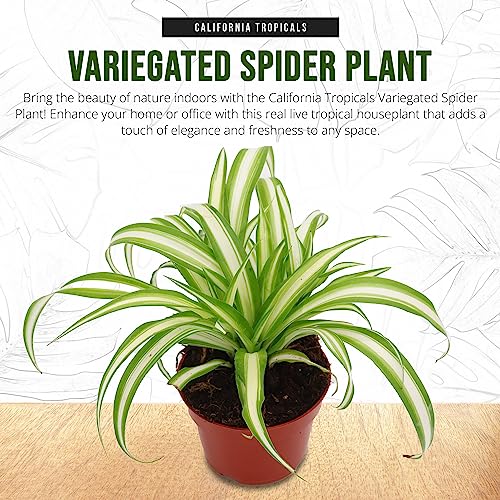
California Tropicals Variegated Spider Plant – Easy Care, Perfect for Pots, Baskets or Patio – 4 Inch
Read more:
Indoor Apartment Gardening: 15 Point Comprehensive Guide
Visit my Amazon Influencer Page for videos and gardening products Grow Your Own Garden




